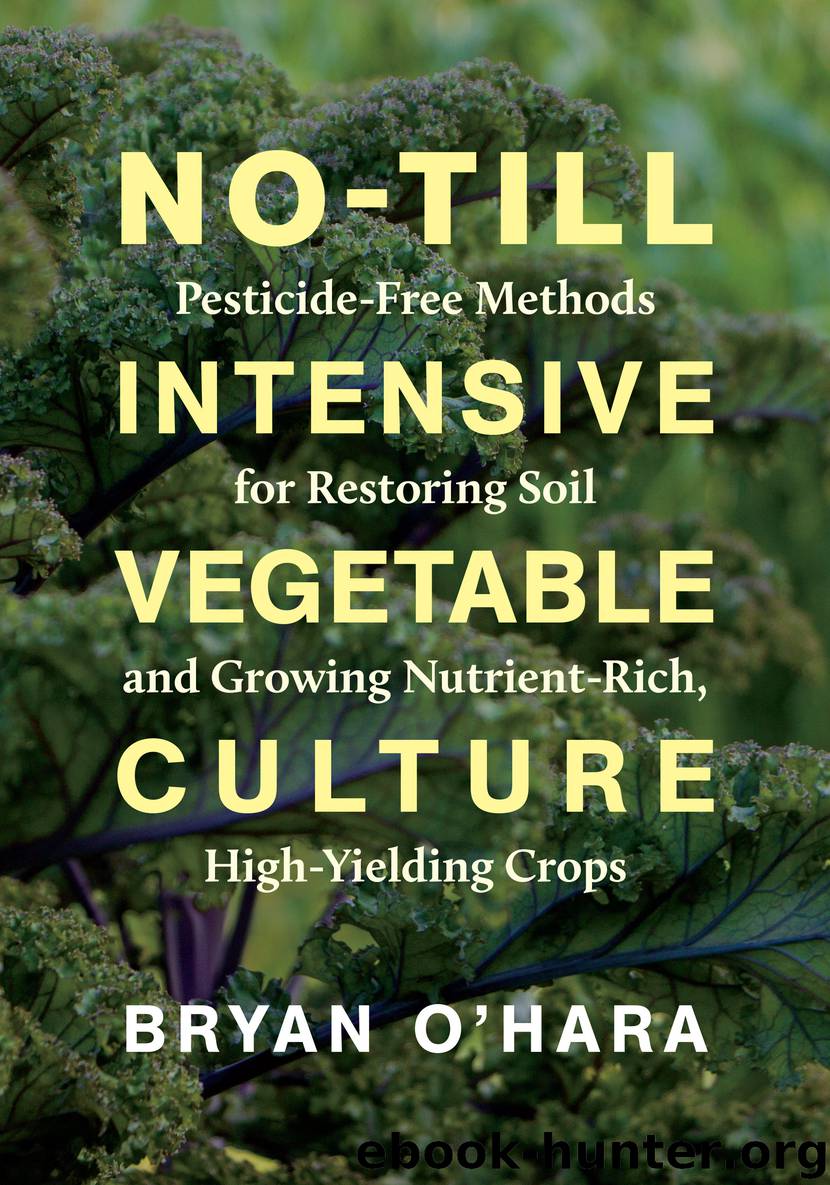No-Till Intensive Vegetable Culture by Bryan O'Hara

Author:Bryan O'Hara
Language: eng
Format: epub
Publisher: Chelsea Green Publishing
CHAPTER 9
Fertilization Materials and Methods
Vegetable growers have traditionally brought large volumes of nutritive materials onto their lands, often at rates approaching 100 tons to the acre (247 metric tons per ha) or more. This is a task that can require a significant amount of effort and is often mechanized. The addition of large volumes of composts and mulches remains the basis of vegetable fertilization efforts, though often this can be supplemented by modern fertilization materials, which may be quite concentrated. Some of the micronutrient materials discussed in this chapter, for example, can supply nutrient needs through very small additions of a few pounds per acre, or even less.
The general objective of most fertilization is the development of improved soil and plant function. However, it is critical that the overarching four elemental conditions have been properly attended to or fertilization efforts will be largely wasted. Attention to the basic principle of keeping the soil covered at all times with both decaying residues and mulches as well as an adequate plant canopy is also primary. Fertilization efforts will impact the balance of growth and reproductive forces as well as characteristics of soils, including aggregation and biological conditions, warmth, water/air, and drainage characteristics. The impacts of fertilization need to be observed thoroughly in concert with all other agricultural techniques because they have an interrelationship that affects the balance conditions. Tillage is a primary consideration in this regard, as well as irrigation and drainage projects.
Growth and decay are a continuous loop; one feeds the other. This loop is intimately tied to the soil’s biological functioning, and the growth and decay cycle is a primary dynamic growers manage in order to enhance soil fertility. As vegetable growers, our goal is to increase this cycle to higher levels of activity, and thus bring about conditions of better crop growth. Indeed, enhancing the growth and decay process is the primary goal of fertilization. Observing how fertilization impacts this dynamic is a critical component of evaluating the appropriateness of fertilization efforts, and thus trials, testing, and guidance are particularly important to help develop our ability to apply the correct fertilization materials at the correct time.
The trialing of fertilization materials is particularly important, often achieved with the simple trial of not applying a fertilizer to a small area as a control for comparison. It is also relatively easy to set up trials of one fertilizer versus another, with repetitions at different times and conditions being even more useful. Supplementing direct observation with soil and tissue analysis of the different treatments may be worthwhile as well. Testing with a refractometer, pH meter, and electrical conductivity meter may also be helpful to compare a fertilized crop with an unfertilized crop and note any benefits or detriments as a result of the application.
There are essentially two approaches to fertilization: the fertilization of soils and the direct fertilization of a crop. The fertilization of soils is the addition of materials so that the soil provides improved conditions and nutrients for crop growth. In
Download
This site does not store any files on its server. We only index and link to content provided by other sites. Please contact the content providers to delete copyright contents if any and email us, we'll remove relevant links or contents immediately.
Craft Beer for the Homebrewer by Michael Agnew(18145)
Marijuana Grower's Handbook by Ed Rosenthal(3623)
Barkskins by Annie Proulx(3314)
Project Animal Farm: An Accidental Journey into the Secret World of Farming and the Truth About Our Food by Sonia Faruqi(3178)
The Plant Messiah by Carlos Magdalena(2883)
Red Famine: Stalin's War on Ukraine by Anne Applebaum(2874)
0041152001443424520 .pdf by Unknown(2785)
Organic Mushroom Farming and Mycoremediation by Tradd Cotter(2631)
In the Woods by Tana French(2534)
Beer is proof God loves us by Charles W. Bamforth(2375)
7-14 Days by Noah Waters(2362)
Reservoir 13 by Jon McGregor(2242)
Borders by unknow(2232)
Meathooked by Marta Zaraska(2220)
The Art of Making Gelato by Morgan Morano(2218)
Birds, Beasts and Relatives by Gerald Durrell(2179)
Between Two Fires by Christopher Buehlman(2168)
The 7 Habits of Highly Effective People: Powerful Lessons in Personal Change (25th Anniversary Edition) by Covey Stephen R(2139)
The Lean Farm Guide to Growing Vegetables: More In-Depth Lean Techniques for Efficient Organic Production by Ben Hartman(2099)
